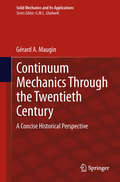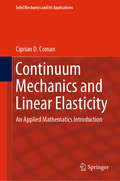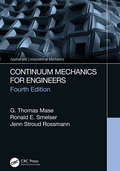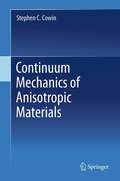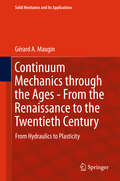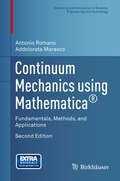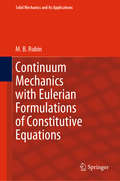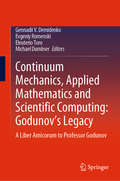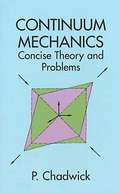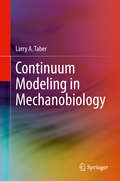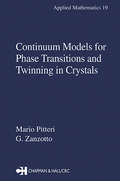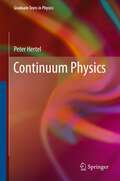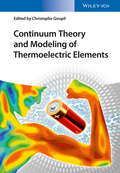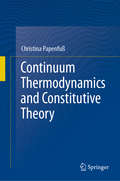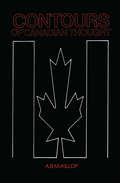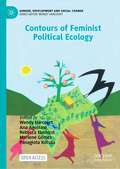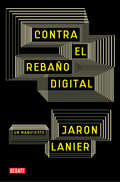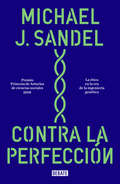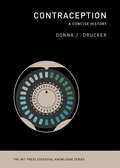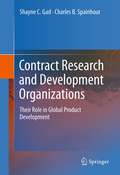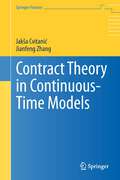- Table View
- List View
Continuum Mechanics Through the Twentieth Century: A Concise Historical Perspective (Solid Mechanics and Its Applications #196)
by Gerard A MauginThis overview of the development of continuum mechanics throughout the twentieth century is unique and ambitious. Utilizing a historical perspective, it combines an exposition on the technical progress made in the field and a marked interest in the role played by remarkable individuals and scientific schools and institutions on a rapidly evolving social background. It underlines the newly raised technical questions and their answers, and the ongoing reflections on the bases of continuum mechanics associated, or in competition, with other branches of the physical sciences, including thermodynamics. The emphasis is placed on the development of a more realistic modeling of deformable solids and the exploitation of new mathematical tools. The book presents a balanced appraisal of advances made in various parts of the world. The author contributes his technical expertise, personal recollections, and international experience to this general overview, which is very informative albeit concise.
Continuum Mechanics and Linear Elasticity: An Applied Mathematics Introduction (Solid Mechanics and Its Applications #238)
by Ciprian D. ComanThis is an intermediate book for beginning postgraduate students and junior researchers, and offers up-to-date content on both continuum mechanics and elasticity. The material is self-contained and should provide readers sufficient working knowledge in both areas. Though the focus is primarily on vector and tensor calculus (the so-called coordinate-free approach), the more traditional index notation is used whenever it is deemed more sensible.With the increasing demand for continuum modeling in such diverse areas as mathematical biology and geology, it is imperative to have various approaches to continuum mechanics and elasticity. This book presents these subjects from an applied mathematics perspective. In particular, it extensively uses linear algebra and vector calculus to develop the fundamentals of both subjects in a way that requires minimal use of coordinates (so that beginning graduate students and junior researchers come to appreciate the power of the tensor notation).
Continuum Mechanics and Thermodynamics
by Ronald E. Miller Ellad B. Tadmor Ryan S. ElliottContinuum mechanics and thermodynamics are foundational theories of many fields of science and engineering. This book presents a fresh perspective on these fundamental topics, connecting micro- and nanoscopic theories and emphasizing topics relevant to understanding solid-state thermo-mechanical behavior. Providing clear, in-depth coverage, the book gives a self-contained treatment of topics directly related to nonlinear materials modeling. It starts with vectors and tensors, finite deformation kinematics, the fundamental balance and conservation laws, and classical thermodynamics. It then discusses the principles of constitutive theory and examples of constitutive models, presents a foundational treatment of energy principles and stability theory, and concludes with example closed-form solutions and the essentials of finite elements. Together with its companion book, Modeling Materials, (Cambridge University Press, 2011), this work presents the fundamentals of multiscale materials modeling for graduate students and researchers in physics, materials science, chemistry and engineering.
Continuum Mechanics and Thermodynamics of Matter
by S. PaolucciAimed at advanced undergraduate and graduate students, this book provides a clear unified view of continuum mechanics that will be a welcome addition to the literature. Samuel Paolucci provides a well-grounded mathematical structure and also gives the reader a glimpse of how this material can be extended in a variety of directions, furnishing young researchers with the necessary tools to venture into brand new territory. Particular emphasis is given to the roles that thermodynamics and symmetries play in the development of constitutive equations for different materials. Continuum Mechanics and Thermodynamics of Matter is ideal for a one-semester course in continuum mechanics, with 250 end-of-chapter exercises designed to test and develop the reader's understanding of the concepts covered. Six appendices enhance the material further, including a comprehensive discussion of the kinematics, dynamics and balance laws applicable in Riemann spaces.
Continuum Mechanics for Engineers (Applied and Computational Mechanics)
by G. Thomas Mase Ronald E. Smelser Jenn Stroud RossmannA bestselling textbook in its first three editions, Continuum Mechanics for Engineers, Fourth Edition provides engineering students with a complete, concise, and accessible introduction to advanced engineering mechanics. It provides information that is useful in emerging engineering areas, such as micro-mechanics and biomechanics. Through a mastery of this volume’s contents and additional rigorous finite element training, readers will develop the mechanics foundation necessary to skillfully use modern, advanced design tools. Features: Provides a basic, understandable approach to the concepts, mathematics, and engineering applications of continuum mechanics Updated throughout, and adds a new chapter on plasticity Features an expanded coverage of fluids Includes numerous all new end-of-chapter problems With an abundance of worked examples and chapter problems, it carefully explains necessary mathematics and presents numerous illustrations, giving students and practicing professionals an excellent self-study guide to enhance their skills.
Continuum Mechanics of Anisotropic Materials
by Stephen C. CowinContinuum Mechanics of Anisotropic Materials(CMAM) presents an entirely new and unique development of material anisotropy in the context of an appropriate selection and organization of continuum mechanics topics. These features will distinguish this continuum mechanics book from other books on this subject. Textbooks on continuum mechanics are widely employed in engineering education, however, none of them deal specifically with anisotropy in materials. For the audience of Biomedical, Chemical and Civil Engineering students, these materials will be dealt with more frequently and greater accuracy in their analysis will be desired. Continuum Mechanics of Anisotropic Materials' author has been a leader in the field of developing new approaches for the understanding of anisotropic materials.
Continuum Mechanics through the Ages - From the Renaissance to the Twentieth Century: From Hydraulics to Plasticity (Solid Mechanics and Its Applications #223)
by Gérard A. MauginMixing scientific, historic and socio-economic vision, thisunique book complements two previously published volumes on the history ofcontinuum mechanics from this distinguished author. In this volume, Gérard A. Maugin looks at the period from the renaissance to the twentieth century and heincludes an appraisal of the ever enduring competition between molecular andcontinuum modelling views. Chapters trace early works in hydraulics and fluid mechanics not covered in theother volumes and the author investigates experimental approaches, essentiallybefore the introduction of a true concept of stress tensor. The treatment ofsuch topics as the viscoelasticity of solids and plasticity, fracture theory,and the role of geometry as a cornerstone of the field, are all explored. Readers will find a kind of socio-historical appraisal of the seminalcontributions by our direct masters in the second half of the twentiethcentury. The analysis of the teaching and research texts by Duhem, Poincaré andHilbert on continuum mechanics is key: these provide the most valuabledocumentary basis on which a revival of continuum mechanics and itsformalization were offered in the late twentieth century. Altogether, the three volumes offer a generous conspectus of the developmentsof continuum mechanics between the sixteenth century and the dawn of thetwenty-first century. Mechanical engineers, applied mathematicians andphysicists alike will all be interested in this work which appeals to allcurious scientists for whom continuum mechanics as a vividly evolving sciencestill has its own mysteries.
Continuum Mechanics using Mathematica®: Fundamentals, Methods, and Applications (Modeling and Simulation in Science, Engineering and Technology)
by Antonio Romano Addolorata MarascoThis textbook's methodological approach familiarizes readers with the mathematical tools required to correctly define and solve problems in continuum mechanics. Covering essential principles and fundamental applications, this second edition of Continuum Mechanics using Mathematica® provides a solid basis for a deeper study of more challenging and specialized problems related to nonlinear elasticity, polar continua, mixtures, piezoelectricity, ferroelectricity, magneto-fluid mechanics and state changes (see A. Romano, A. Marasco, Continuum Mechanics: Advanced Topics and Research Trends, Springer (Birkhäuser), 2010, ISBN 978-0-8176-4869-5). Key topics and features: * Concise presentation strikes a balance between fundamentals and applications * Requisite mathematical background carefully collected in two introductory chapters and one appendix * Recent developments highlighted through coverage of more significant applications to areas such as wave propagation, fluid mechanics, porous media, linear elasticity. This second edition expands the key topics and features to include: * Two new applications of fluid dynamics: meteorology and navigation * New exercises at the end of the existing chapters * The packages are rewritten for Mathematica 9 Continuum Mechanics using Mathematica®: Fundamentals, Applications and Scientific Computing is aimed at advanced undergraduates, graduate students and researchers in applied mathematics, mathematical physics and engineering. It may serve as a course textbook or self-study reference for anyone seeking a solid foundation in continuum mechanics.
Continuum Mechanics with Eulerian Formulations of Constitutive Equations (Solid Mechanics and Its Applications #265)
by M.B. RubinThis book focuses on the need for an Eulerian formulation of constitutive equations. After introducing tensor analysis using both index and direct notation, nonlinear kinematics of continua is presented. The balance laws of the purely mechanical theory are discussed along with restrictions on constitutive equations due to superposed rigid body motion. The balance laws of the thermomechanical theory are discussed and specific constitutive equations are presented for: hyperelastic materials; elastic–inelastic materials; thermoelastic–inelastic materials with application to shock waves; thermoelastic–inelastic porous materials; and thermoelastic–inelastic growing biological tissues.
Continuum Mechanics, Applied Mathematics and Scientific Computing: A Liber Amicorum to Professor Godunov (Advanced Structured Materials Ser. #107)
by Gennadii V. Demidenko Evgeniy Romenski Eleuterio Toro Michael DumbserThis book is a liber amicorum to Professor Sergei Konstantinovich Godunov and gathers contributions by renowned scientists in honor of his 90th birthday. The contributions address those fields that Professor Godunov is most famous for: differential and difference equations, partial differential equations, equations of mathematical physics, mathematical modeling, difference schemes, advanced computational methods for hyperbolic equations, computational methods for linear algebra, and mathematical problems in continuum mechanics.
Continuum Mechanics: Concise Theory and Problems (Dover Books on Physics)
by P. ChadwickWritten in response to the dearth of practical and meaningful textbooks in the field of fundamental continuum mechanics, this comprehensive treatment offers students and instructors an immensely useful tool. Its 115 solved problems and exercises not only provide essential practice but also systematically advance the understanding of vector and tensor theory, basic kinematics, balance laws, field equations, jump conditions, and constitutive equations.Readers follow clear, formally precise steps through the central ideas of classical and modern continuum mechanics, expressed in a common, efficient notation that fosters quick comprehension and renders these concepts familiar when they reappear in other contexts. Completion of this brief course results in a unified basis for work in fluid dynamics and the mechanics of solid materials, a foundation of particular value to students of mathematics and physics, those studying continuum mechanics at an intermediate or advanced level, and postgraduate students in the applied sciences. "Should be excellent in its intended function as a problem book to accompany a lecture course." -- Quarterly of Applied Math.
Continuum Mechanics: Elasticity, Plasticity, Viscoelasticity
by Ellis H. DillMost books on continuum mechanics focus on elasticity and fluid mechanics. But whether student or practicing professional, modern engineers need a more thorough treatment to understand the behavior of the complex materials and systems in use today. Continuum Mechanics: Elasticity, Plasticity, Viscoelasticity offers a complete tour of the subject th
Continuum Modeling in Mechanobiology
by Larry A. TaberThis book examines key theoretical tools that are currently used to develop mathematical models as an aid in understanding the biological response of cells and tissues to mechanical stimuli. Problems in growth and remodeling, tissue and organ development, and functional adaptation are all covered. Chapters on tensor analysis and nonlinear elasticity provide the necessary background for understanding the engineering theories that are currently used to solve challenges in mechanobiology. This is an ideal book for biomechanical engineers who work on problems in mechanobiology and tissue engineering.
Continuum Modeling: An Approach Through Practical Examples (SpringerBriefs in Applied Sciences and Technology)
by Adrian MunteanThis book develops continuum modeling skills and approaches the topic from three sides: (1) derivation of global integral laws together with the associated local differential equations, (2) design of constitutive laws and (3) modeling boundary processes. The focus of this presentation lies on many practical examples covering aspects such as coupled flow, diffusion and reaction in porous media or microwave heating of a pizza, as well as traffic issues in bacterial colonies and energy harvesting from geothermal wells. The target audience comprises primarily graduate students in pure and applied mathematics as well as working practitioners in engineering who are faced by nonstandard rheological topics like those typically arising in the food industry.
Continuum Models for Phase Transitions and Twinning in Crystals (Applied Mathematics)
by Mario Pitteri G. ZanzottoContinuum Models for Phase Transitions and Twinning in Crystals presents the fundamentals of a remarkably successful approach to crystal thermomechanics. Developed over the last two decades, it is based on the mathematical theory of nonlinear thermoelasticity, in which a new viewpoint on material symmetry, motivated by molecular theories, plays a c
Continuum Physics (Graduate Texts in Physics)
by Peter HertelThis small book on the properties of continuously distributed matter covers a huge field. It sets out the governing principles of continuum physics and illustrates them by carefully chosen examples. These examples comprise structural mechanics and elasticity, fluid media, electricity and optics, thermoelectricity, fluctuation phenomena and more, from Archimedes' principle via Brownian motion to white dwarfs. Metamaterials, pattern formation by reaction-diffusion and surface plasmon polaritons are dealt with as well as classical topics such as Stokes' formula, beam bending and buckling, crystal optics and electro- and magnetooptic effects, dielectric waveguides, Ohm's law, surface acoustic waves, to mention just some. The set of balance equations for content, flow and production of particles, mass, charge, momentum, energy and entropy is augmented by material, or constitutive equations. They describe entire classes of materials, such as viscid fluids and gases, elastic media, dielectrics or electrical conductors. We discuss the response of matter to rapidly oscillating external parameters, in particular the electric field strength of light, in the framework of statistical thermodynamics.< An appendix on fields and a glossary round off this bird's-eye view on continuum physics. Students of physics, engineering and related fields will benefit from the clear presentation of worked examples and the variety of solution methods, including numerical techniques. Lecturers or advanced students may profit from the unified view on a substantial part of physics. It may help them to embed their research field conceptually within a wider context.
Continuum Theory and Modeling of Thermoelectric Elements
by Christophe GoupilSound knowledge of the latest research results in the thermodynamics and design of thermoelectric devices, providing a solid foundation for thermoelectric element and module design in the technical development process and thus serving as an indispensable tool for any application development. The text is aimed mainly at the project developer in the field of thermoelectric technology, both in academia and industry, as well as at graduate and advanced undergraduate students. Some core sections address the specialist in the field of thermoelectric energy conversion, providing detailed discussion of key points with regard to optimization. The international team of authors with experience in thermoelectrics research represents such institutes as EnsiCaen Université de Paris, JPL, CalTech, and the German Aerospace Center.
Continuum Thermodynamics and Constitutive Theory
by Christina PapenfußThis book presents different thermodynamic approaches in the area of constitutive theory: thermodynamics of irreversible processes, rational thermodynamics, and extended thermodynamics. These different approaches are analyzed with respect to their presuppositions, as well as to their results, and each method is applied to several important examples. In many cases these examples are archetypes for numerous technologically important materials; i.e. complex materials having an internal structure. Some of the examples dealt with in this book are liquid crystals, colloid suspensions, ans fiber suspensions. The book well serves students and researchers who have basic knowledge in continuum mechanics and thermodynamics. It provides a systematic overview of the vast field of thermodynamic constitutive theory, beginning from a historical perspective and concluding with outstanding questions in recent research.
Contours of Canadian Thought
by A. B. MckillopThe leaps of knowledge in nineteenth-century science shook the foundations of religious and humanistic values throughout much of the world. The Darwinian Revolution and similar developments presented enormous philosophical challenges to Canadian scientists, philosophers, and men of letters. Their responses, many and varied, form a central theme in this collection of essays by one of Canada's leading intellectual historians.McKillop explores the thought of a number of English-Canadian thinkers from the 1860s to the 1920s, decades that saw Canada's entry into the modern age. We meet Daniel Wilson, an educator and ethnologist for whom the pursuit of science was a form of poetic engagement, requiring the poet's sensibilities; John Watson, one of the world's leading exponents of objective idealism, whose philosophical premises helped to undermine the very religious tradition he sought to bolster; and William Dawson LeSueur, an apostle of Positivism, whose spirited defence of critical inquiry and evolutionary social ethics led him towards an entirely contradictory position.In addition to profiles of individuals, McKillop considers the ways in which their ideas operated in the context of Canadian institutions including the universities and the press. From these prospectives emerges a detailed analysis of the life of the mind of English Canada in an age of questioning, of doubt, and of struggle to reorient the intellectual and philosophical positions of a quickly changing society.
Contours of Feminist Political Ecology (Gender, Development and Social Change)
by Wendy Harcourt Rebecca Elmhirst Panagiota Kotsila Ana Agostino Marlene GómezThis open access book sets out the contours of feminist political ecology (FPE) as a major contribution to ongoing debates in the field. As Professor Lyla Mehta says in her Foreword, the book is "foregrounding multiple ways of knowing and being, thus enabling new conceptions of politics, justice and alternatives to dominant, capitalist development trajectories". In an innovative methodological twist, the edited book engages the reader in conversations that have emerged from the multi-sited and cross-generational dialogues of the Well-Being Ecology Gender cOmmunities (WEGO) network over the last four years. The conversations explore topics that range from climate change and extractivism, to body politics and health, degrowth, care and community well-being. The authors reflect on their collective learning process as they map out the new directions of FPE research and analysis. The chapters highlight WEGO transnational/transdisciplinary conversations with local communities, social movements and different academic spaces. The book foregrounds the ethics of doing feminist work inside and outside academe and brings to life the importance of doing reflexive research aware of situated historical and contemporary geographical contours of power.
Contra el rebaño digital: Un manifiesto
by Jaron LanierEl fascinante manifiesto por un uso creativo de la tecnología de uno de los creadores de Internet. Contra el rebaño digital es uno de los libros que más han dado que hablar en los últimos tiempos: un aviso contra nuestra obsesión por la tecnología y, en concreto, por internet, escrito por uno de los expertos más estimulantes y visionarios. La temprana dedicación de Lanier a la realidad virtual y el desarrollo de tecnologías en red son legendarias, así como sus artículos, que atacan muchas de las cuestiones que el mundo de la tecnología considera sagradas. En este manifiesto, Lanier apunta contra lo que ha bautizado como la cultura nerd de internet o el «maoísmo digital», es decir, la tendencia de la comunidad tecnológica de primar la plataforma sobre el contenido y los ordenadores sobre las personas. En total contraste con los que saludan el triunfo del contenido generado por los usuarios, Lanier ve una internet desinformada y tediosa, en la que la cantidad se impone a la calidad y las buenas ideas son acalladas a base de gritos. Pero Contra el rebaño digital no es una diatriba antitecnológica. Es un manifiesto fresco y energizante dedicado a quienes la tecnología les inspira aunque les decepcione el modo en que es empleada. Lanier propone a los usuarios de la red frenar un poco, generar contenidos profundos en vez de llamativos y sacar el máximo partido de internet en vez de usarla ciegamente para todo. Reseñas: «Aunque Lanier no pertenece a mi generación, nos conoce y nos comprende bien, y ha escrito un libro breve y aterrador, Contra el rebaño digital, que se hace eco de mi propia incomodidad, pero partiendo de un conocimiento y una perspicacia reales, tanto en lo práctico como en lo filosófico.» Zadie Smith, The New York Review of Books «Lúcido, poderoso y persuasivo. Una lectura imprescindible para todos aquellos que observan cómo la red y la tecnología que usamos a diario están modelando la cultura y el mercado.» Michiko Kakutani, The New York Times «Este es el libro más importante escrito hasta la fecha sobre nuestro mundo cada vez más digitalizado. Será recordado como el manifiesto que salvó a la humanidad al límite de la extinción, o como el último mensaje inteligente de una especie obsoleta.» Douglas Rushkoff «Apasionante y estimulante. Un correctivo necesario en los salones de debates tecnológicos.» San Francisco Chronicle «Importante... Lo que subyace en el ciberpensamiento de Lanier es una fe fundamentalmente humanista en la tecnología.» Los Angeles Times «Para quienes quieren leer para pensar, y leer para transformar, Contra el rebaño digital es el libro con el que empezar la década. Crudo, alborotador e inesperado. Y también muy entretenido.» Times Higher Education Supplement «El libro fundamental para comprender el mundo después de Google.» The Stranger (Seattle) «Poético y profético, este puede ser el libro más importante del año. ¡Lee este libro y álzate contra la rigidez de la red!» The Times (Londres) «Inspirado, enojoso y totalmente necesario. Bienvenidos al primer gran llamamiento del siglo en defensa de un "nuevo humanismo digital" frente a la conformidad en red del ciberespacio.» The Independent «Un nuevo y convincente manifiesto... Lanier es el primer gran apóstata de la era de internet.» Newsweek
Contra la perfección: La ética en la era de la ingeniería genética
by Michael J. Sandel¿Qué tiene de malo manipular nuestra naturaleza o la de otros seres? El filósofo Michael Sandel trata de responder a esta pregunta a través de un ameno pero profundo repaso del campo de la bioética. Desde hace tiempo es evidente que la ciencia va más deprisa de lo que nuestras intuiciones morales son capaces de asumir: hoy ya es materialmente posible encargar una mascota exactamente igual que la que acabamos de enterrar; o reivindicar que se asegure que nuestros hijos tendrán las mismas determinaciones genéticas que nosotros, incluso cuando consisten en algo como la sordera. La mayoría de las personas se sienten cuando menos incómodas ante algunas de las posibilidades que abre la ingeniería genética, aunque no siempre les resulta fácil explicar por qué. ¿Qué tiene de malo manipular nuestra naturaleza? ¿Dónde están las líneas rojas, si las hay?Contra la perfección explora estos y otros dilemas morales relacionados con la búsqueda de nuestro propio perfeccionamiento. Sandel argumenta que la búsqueda de la perfección es imperfecta por razones que van más allá de la seguridad y de la equidad, y nos lleva más allá de los familiares términos del discurso político para mostrarnos que la revolución genética transformará el modo en que se discute sobre cuestiones éticas y obligará a reintroducir las cuestiones de orden espiritual en el centro del debate político. Para debatir sobre la ética del perfeccionamiento es preciso abordar preguntas que el mundo moderno ha ignorado desde hace décadas, en gran medida porque bordean el terreno tradicional de la teología. Pero nuestros nuevos poderes en el ámbito de la biotecnología hacen inevitables estas preguntas. Abordarlas es la tarea de este libro, escrito por uno de los filósofos políticos más notables de nuestro tiempo.
Contraception: A Concise History (The MIT Press Essential Knowledge series)
by Donna J. DruckerThe development, manufacturing, and use of contraceptive methods from the late nineteenth century to the present, viewed from the perspective of reproductive justice.The beginning of the modern contraceptive era began in 1882, when Dr. Aletta Jacobs opened the first birth control clinic in Amsterdam. The founding of this facility, and the clinical provision of contraception that it enabled, marked the moment when physicians started to take the prevention of pregnancy seriously as a medical concern. In this volume in the MIT Press Essential Knowledge series, Donna Drucker traces the history of modern contraception, outlining the development, manufacturing, and use of contraceptive methods from the opening of Dr. Jacobs's clinic to the present. Drucker approaches the subject from the perspective of reproductive justice: the right to have a child, the right not to have a child, and the right to parent children safely and healthily.Drucker describes contraceptive methods available before the pill, including the diaphragm (dispensed at the Jacobs clinic) and condom, spermicidal jellies, and periodic abstinences. She looks at the development and dissemination of the pill and its chemical descendants; describes technological developments in such non-hormonal contraceptives as the cervical cap and timing methods (including the “rhythm method” favored by the Roman Catholic church); and explains the concept of reproductive justice. Finally, Drucker considers the future of contraception—the adaptations of existing methods, new forms of distribution, and ongoing efforts needed to support contraceptive access worldwide.
Contract Research and Development Organizations: Their Role in Global Product Development
by Shayne C. Gad Charles B. SpainhourThe last 10 years have seen a seismic shift in therapeutic product development and testing. In both the pharmaceutical (both small and large molecule) and medical device sectors, the vast majority of testing and evaluation of products is not performed within innovator companies, but rather has been outsourced to a growing universe of commercial organizations. The authors both have more than 30 years experience in this field, and both have worked within innovator companies, for CROs, and as consultants in the field. Contract Research and Development Organizations: Their Role in Global Product Development has been crafted by these authors to provide a how to guide for all aspects of working with CROs in selecting, working with and ensuring the best possible desirable outcome of having the R&D function, or substantial parts of it, outsourced. It uses as the exemplary case nonclinical safety assessment, biocompatibility and efficacy testing which are to be performed to select the best possible candidate compound, device or formulation and then moving the resulting regulated therapeutic medical product into and through the development process and to marketing approval. But also covered are the contract synthesis of drug substances and corresponding manufacture of biologics and manufacture of products, formulation development, clinical evaluation, regulatory and document preparation support, and use of consultants. Included in the volume are an exhaustive listing of those CROs in the (drug and device) safety evaluation sector and their contact information and capabilities, and extensive similar listing for the other types of contract service providers. Also included are guidances on how to monitor ongoing work at contract facilities and audit check lists for GLP, GMP and GCP facilities. These listings are international in scope, and a specific chapter addresses working with some of the newer international CROs.
Contract Theory in Continuous-Time Models (Springer Finance)
by Jianfeng Zhang Jakša CvitanicIn recent years there has been a significant increase of interest in continuous-time Principal-Agent models, or contract theory, and their applications. Continuous-time models provide a powerful and elegant framework for solving stochastic optimization problems of finding the optimal contracts between two parties, under various assumptions on the information they have access to, and the effect they have on the underlying "profit/loss" values. This monograph surveys recent results of the theory in a systematic way, using the approach of the so-called Stochastic Maximum Principle, in models driven by Brownian Motion. Optimal contracts are characterized via a system of Forward-Backward Stochastic Differential Equations. In a number of interesting special cases these can be solved explicitly, enabling derivation of many qualitative economic conclusions.
